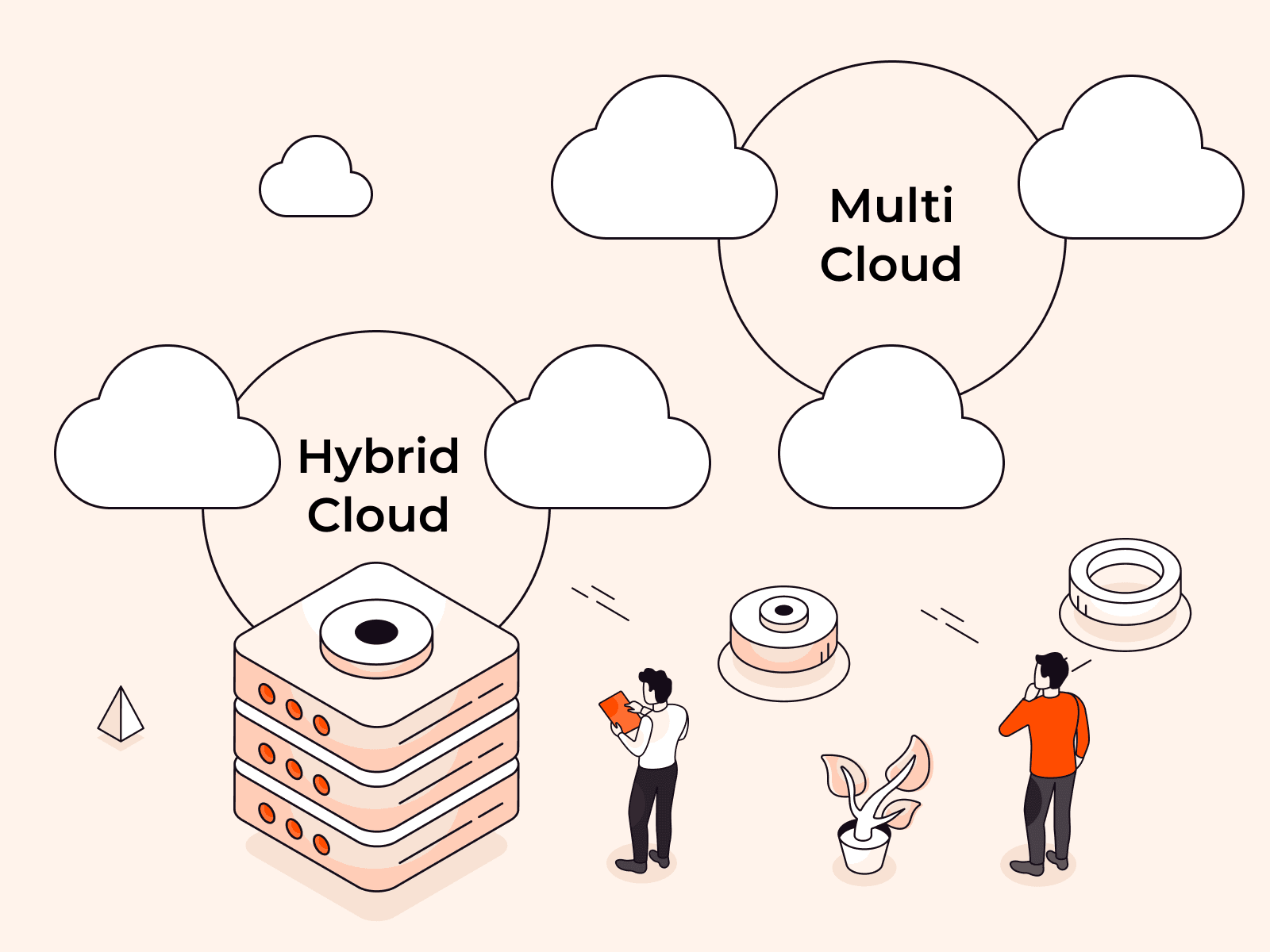What is a hybrid cloud? Benefits, use cases, and implementation
- By Gcore
- September 22, 2025
- 10 min read

Hybrid cloud combines your private infrastructure (on-premises data centers or dedicated servers) with public cloud services through orchestration platforms that let workloads move seamlessly between environments. You can run sensitive workloads on private infrastructure while tapping into public cloud resources for flexibility, cost optimization, and geographic reach. Organizations report 35% average IT cost reductions by placing workloads where they perform best economically.
The architecture relies on cloud management platforms like Kubernetes-based orchestrators that provide unified control across both environments. When you need extra computing power during peak demand, workloads can burst from your private infrastructure to public cloud resources automatically. This flexibility explains why 89% of organizations now operate in hybrid or multi-cloud environments, with Gartner forecasting that 92% of enterprises will have hybrid cloud strategies by 2027.
What makes hybrid cloud particularly valuable is its ability to balance competing priorities. You can keep regulated data on private infrastructure to meet compliance requirements like GDPR or HIPAA while using public cloud for development, testing, or disaster recovery. The model supports edge computing integration for low-latency applications and lets AI workloads train on private data while using public GPU resources for inference. Hybrid setups reduce downtime by 50% through automated failover mechanisms that switch between environments when issues occur.
The shift toward hybrid cloud reflects practical business needs rather than pure technology trends. Companies avoid vendor lock-in, improve costs through workload placement, and maintain control over critical systems while accessing cloud innovation. The hybrid cloud market is projected to reach $119.2 billion by 2028, growing at 23.5% annually as more organizations recognize that no single environment fits all workload requirements.
What is a hybrid cloud?
Hybrid cloud combines private infrastructure (your own data center or dedicated servers) with public cloud services, letting workloads move between environments based on your needs. You keep sensitive data on-premises while tapping into public cloud resources for flexibility. About 89% of enterprises currently operate this way to avoid vendor lock-in and improve costs.
How does a hybrid cloud work?
Hybrid cloud connects private infrastructure with public cloud services through orchestration platforms and APIs that move workloads seamlessly between environments. Cloud management tools like Kubernetes or specialized platforms create a unified control plane across both environments, letting you run applications wherever they perform best.
Here's the basic flow. Your orchestration layer monitors workload demands and automatically routes tasks based on predefined policies. Non-sensitive workloads might run on public cloud for cost effectiveness, while regulated data stays on private infrastructure. The connection happens through encrypted VPN tunnels or dedicated network links that maintain security while syncing data in real-time.
The key mechanism is abstraction. Instead of managing separate environments, you define policies once (security rules, compliance requirements, performance thresholds) and the platform enforces them everywhere. When demand spikes, the system can burst workloads to public cloud automatically, then scale back down when traffic normalizes. This cloud bursting approach delivers those 60% to 70% cost savings McKinsey reports for non-critical workloads.
Data portability relies on containerization and standardized APIs. Applications packaged in containers can move between environments without reconfiguration, while APIs handle authentication, monitoring, and resource allocation across your entire infrastructure. Organizations using these orchestration tools report 50% less downtime through automated failover capabilities.
What are hybrid cloud benefits?
Hybrid cloud benefits are the practical advantages organizations gain from combining private and public cloud environments into a unified architecture. The benefits are listed below.
- Cost optimization: Organizations achieve 35% average reductions in IT costs by running workloads where they're most economical. You can keep sensitive data on private infrastructure while bursting non-critical workloads to public cloud during peak demand, delivering 60% to 70% savings on variable compute needs.
- Enhanced flexibility: Teams gain freedom to choose the best environment for each application based on performance, compliance, or cost requirements. This architectural approach lets you avoid vendor lock-in while adapting infrastructure as business needs change, with 89% of organizations using this strategy to maintain control.
- Improved scalability: You can scale resources up or down instantly without massive capital investments in physical hardware. When traffic spikes hit, public cloud resources handle overflow automatically while your private infrastructure maintains baseline operations at predictable costs.
- Better disaster recovery: Hybrid setups reduce downtime by 50% through automated failover between environments. Your primary applications run on private cloud while replicas sync continuously to public cloud, ensuring business continuity if one environment fails.
- Regulatory compliance: Sensitive data stays on private infrastructure to meet GDPR, HIPAA, or industry-specific requirements while less-regulated workloads use public cloud economics. This separation lets you balance compliance obligations with operational efficiency.
- Faster innovation: Development teams achieve 2.5x faster time-to-market by testing in public cloud environments before production deployment on private infrastructure. You can experiment with new technologies without disrupting existing systems or compromising security.
- Edge computing integration: Hybrid architectures support low-latency applications by processing data closer to users through edge nodes while maintaining centralized control. This matters for IoT deployments, real-time analytics, and applications where milliseconds impact user experience.
- Workload optimization: Different applications have different needs. AI training benefits from private GPU clusters while inference scales better on public resources. You can match each workload to its ideal environment rather than forcing everything into one model.
What are common hybrid cloud use cases?
Hybrid cloud use cases span scenarios where organizations need to balance performance, security, cost, and compliance across different computing environments. The common use cases are listed below.
- Disaster recovery: Organizations replicate critical applications and data from private infrastructure to public cloud environments, allowing automated failover if primary systems fail. This approach reduces downtime by 50% compared to traditional backup methods while eliminating the cost of maintaining redundant physical data centers.
- Cloud bursting: Applications run on private infrastructure during normal operations but automatically scale to public cloud resources when demand spikes. Retailers use this during holiday sales, financial institutions during quarter-end processing, and media companies during live events, cutting costs by 60% to 70% on peak capacity.
- Data sovereignty and compliance: Regulated industries keep sensitive data on-premises or in specific geographic regions while using public cloud for non-sensitive workloads. Healthcare providers process patient records privately under HIPAA requirements while running analytics in public environments, and financial services maintain transaction data locally while using cloud-based customer portals.
- Application modernization: Legacy applications remain on private infrastructure while new microservices deploy to public cloud, allowing gradual migration without disrupting operations. This lets organizations modernize at their own pace. Capital One moved 95% of workloads this way, achieving 99.99% uptime throughout the transition.
- AI and machine learning: Organizations train models on sensitive private data while running inference workloads on public cloud GPU resources. This separates proprietary datasets from flexible compute power, letting companies access advanced AI capabilities without exposing confidential information.
- Edge computing integration: IoT devices and edge locations process data locally for low-latency responses while syncing to centralized cloud systems for analysis. Manufacturing plants monitor equipment in real-time at the edge, then aggregate performance data in the cloud. Siemens boosted supply chain efficiency 25% using this pattern.
- Development and testing: Teams build and test applications in public cloud environments while running production workloads on private infrastructure. This separates experimental work from stable operations, reducing costs since development environments don't need the same performance guarantees as production systems.
- Multi-cloud strategy: Organizations distribute workloads across different providers to avoid vendor lock-in while maintaining private infrastructure for core systems. This approach gives you flexibility to choose the best service for each workload. About 89% of enterprises now operate this way to maintain negotiating power and prevent dependency on a single provider.
What are the main hybrid cloud challenges?
Hybrid cloud challenges refer to the technical, operational, and organizational obstacles that arise when combining private and public cloud environments. These challenges are listed below.
- Complexity in management: Orchestrating workloads across multiple environments requires specialized tools and expertise. Organizations often struggle with inconsistent APIs, different security models, and varied operational processes between private and public clouds. According to IDC, 62% of enterprises cite management complexity as their primary hybrid cloud barrier.
- Data security and compliance: Maintaining consistent security policies across hybrid environments creates significant risk exposure. You'll need to implement encryption, identity management, and access controls that work seamlessly between on-premises and cloud systems. Regulated industries face additional challenges ensuring GDPR, HIPAA, or FedRAMP compliance when data moves between environments.
- Network latency and bandwidth: Moving large datasets between private and public clouds can introduce performance bottlenecks. Applications requiring real-time data synchronization often experience delays that impact user experience. The cost of data egress from public clouds can also become substantial. Some organizations report unexpected bandwidth charges exceeding 20% of their cloud budget.
- Skill gaps and training: Your IT team needs expertise in both traditional infrastructure and cloud-native technologies. Finding professionals who understand networking, security, containerization, and multiple cloud platforms is difficult. Gartner reports that 75% of organizations lack sufficient staff with hybrid cloud skills, forcing them to invest heavily in training or managed services.
- Cost visibility and control: Tracking expenses across hybrid environments is notoriously difficult without proper FinOps tools. Public cloud costs can spiral quickly through resource sprawl, while private infrastructure carries fixed expenses regardless of usage. Organizations report spending 30% more than budgeted in their first year of hybrid adoption due to poor cost governance.
- Vendor lock-in risks: Proprietary tools and services from cloud providers can trap you in specific ecosystems. Migrating workloads between platforms becomes expensive and time-consuming when you've built dependencies on vendor-specific features. This concern drives 89% of enterprises to prioritize open-source orchestration platforms like Kubernetes.
- Application compatibility: Legacy applications often weren't designed for cloud environments and require significant refactoring. You'll face decisions about whether to modernize, containerize, or maintain apps in their current state. The technical debt from incompatible systems can delay hybrid cloud benefits by months or years.
- Disaster recovery coordination: Ensuring consistent backup and failover processes across hybrid environments demands careful planning. You need to test recovery procedures regularly and maintain data synchronization without introducing single points of failure. Organizations using automated orchestration tools reduce downtime by 50%, but implementation requires substantial upfront investment.
How to use hybrid cloud successfully?
You use hybrid cloud successfully by assessing your workloads first, then choosing the right orchestration platform, and establishing clear governance policies from day one.
- Start with a complete workload assessment. Map out which applications need private infrastructure for compliance or security, and which can run on public cloud for cost effectiveness. Use tools like FinOps frameworks to analyze current spending patterns and identify workloads that'll benefit most from migration. This step typically takes 30 to 45 days but prevents costly mistakes later.
- Select an orchestration platform that fits your technical stack. If you're running containerized applications, Kubernetes-native platforms work best for portability across environments. For VM-based workloads, look at management platforms that support both legacy systems and modern architectures. The right choice depends on your team's skills and existing infrastructure. Don't pick technology that requires complete retraining.
- Establish network connectivity between environments early. Set up dedicated connections or VPNs with encryption to ensure secure data transfer. You'll need bandwidth that can handle peak loads without latency issues. Most organizations underestimate this requirement. Test failover scenarios before going live to catch connectivity problems.
- Implement unified identity and access management across all environments. Use single sign-on and zero-trust security models so users authenticate once regardless of where applications run. This approach reduces security gaps that emerge when managing separate access controls for each environment.
- Create clear data governance policies that specify where different data types can reside. Document compliance requirements like GDPR or HIPAA, and configure automated controls that prevent regulated data from moving to non-compliant locations. Organizations that skip this step face audit failures and potential fines.
- Set up monitoring and cost management tools that provide visibility across both environments. You can't improve what you can't measure. Implement dashboards that track performance metrics, resource usage, and spending in real time. This visibility helps you spot inefficiencies quickly, like workloads running on expensive public cloud instances when cheaper private resources sit idle.
- Train your teams on hybrid operations before launch. Your staff needs to understand how to deploy applications, troubleshoot issues, and manage resources across different environments. The 35% cost reduction that organizations achieve with hybrid cloud comes partly from teams knowing how to place workloads optimally.
- Start with non-critical workloads for your initial implementation. Test your hybrid setup with applications that won't cause business disruption if something goes wrong. Once you've proven the architecture works and your team understands the operations, migrate mission-critical applications with confidence.
The key thing is treating implementation as an ongoing process, not a one-time project. Organizations that succeed review their workload placement quarterly and adjust based on changing business needs and cost patterns.
How can Gcore help with hybrid cloud implementation?
Gcore's global edge network makes hybrid cloud implementation faster and more cost-effective, especially if you need low-latency performance across multiple regions. With 210+ points of presence worldwide, you'll get infrastructure that's closer to your users than traditional hyperscalers.
Here's what sets us apart. Gcore's edge computing platform delivers 40% lower latency for hybrid deployments compared to major cloud providers. You can run workloads on private infrastructure while bursting to Gcore's public cloud during peak demand, with seamless orchestration through Kubernetes-native tools. The platform includes built-in CDN capabilities, so your hybrid applications benefit from both compute and content delivery optimization without managing separate services.
Ready to improve your hybrid cloud strategy? Explore Gcore's edge and cloud solutions
Frequently asked questions
What's the difference between hybrid cloud and multicloud?
Hybrid cloud connects private and public cloud infrastructure for a single organization, while multicloud uses multiple public cloud providers without necessarily combining them. The key difference: hybrid cloud focuses on orchestration between your private infrastructure and public services, whereas multicloud spreads workloads across different vendors to avoid lock-in.
Here's what this means in practice. With hybrid cloud, you're running a unified environment where workloads move seamlessly between your data center and public cloud based on performance, cost, or compliance needs. Multicloud means you might run analytics on one provider, host applications on another, and store backups with a third, but these environments often operate independently. About 89% of organizations now use some combination of both approaches, mixing hybrid architecture with multiple public cloud vendors to maximize flexibility.
How much does hybrid cloud implementation cost?
Hybrid cloud implementation costs typically range from $100,000 to $2 million annually, depending on your infrastructure scale, orchestration platform choice, and workload distribution. Small deployments using open-source tools like Kubernetes cost $100,000 to $300,000 yearly, while enterprise setups with commercial management platforms run $500,000 to $2 million when you factor in licensing, networking, and integration expenses.
Is hybrid cloud more secure than public cloud?
Not necessarily. It depends on your implementation. Hybrid cloud can offer stronger security for sensitive data by keeping it on-premises while using public cloud for less critical workloads, but only if you configure proper encryption, access controls, and network segmentation across both environments. Public clouds typically provide enterprise-grade security features that many organizations can't replicate on-premises, so the security advantage comes from choosing where each workload lives based on its compliance and risk requirements.
What are the technical requirements for hybrid cloud?
Technical requirements for hybrid cloud include a cloud management platform (like Kubernetes, VMware, or Red Hat OpenShift) to orchestrate workloads across environments, high-speed network connectivity between private and public clouds (typically 10 Gbps or higher for production workloads), and unified identity management systems for consistent access control. You'll also need compatible APIs or middleware to move data between platforms, encryption tools for data in transit and at rest, and monitoring solutions that provide visibility across all infrastructure components.
How long does hybrid cloud migration take?
Migration timelines typically range from three to 18 months depending on workload complexity, with simple lift-and-shift migrations completing in 90 to 120 days and complex re-architecting projects requiring 12 to 18 months. Organizations that start with a pilot workload and use assessment tools for dependency mapping can reduce timelines by 30% compared to full-scale migrations without proper planning.
Which applications work best in hybrid cloud environments?
Applications with variable workloads, like e-commerce platforms during seasonal spikes or development environments needing rapid testing, work best in hybrid cloud. You can burst to public cloud resources when demand peaks while keeping steady-state operations on private infrastructure. Data-intensive applications such as AI model training, financial analytics, and healthcare imaging also thrive in hybrid setups. You can process sensitive data on-premises to meet compliance requirements while using public cloud GPU clusters for compute-heavy tasks, reducing costs by 35% compared to fully private deployments.
What skills do teams need for hybrid cloud management?
Teams need cloud architects with multi-platform expertise, DevOps engineers skilled in Kubernetes and CI/CD automation, security specialists trained in zero-trust architecture, and FinOps analysts to manage costs across environments. You'll also want network engineers who understand software-defined networking and site reliability engineers experienced with monitoring tools like Prometheus or Grafana for unified observability across your hybrid infrastructure.
Related articles
Subscribe to our newsletter
Get the latest industry trends, exclusive insights, and Gcore updates delivered straight to your inbox.





